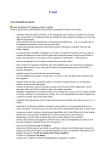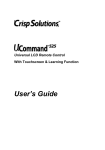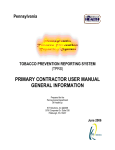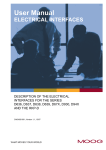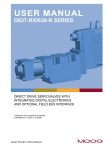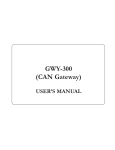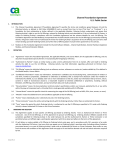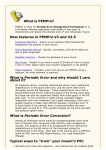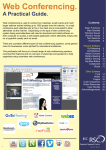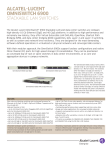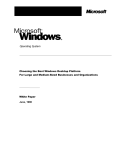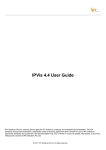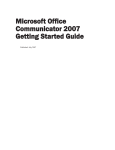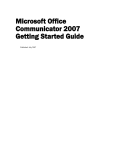Download Microsoft Lync Managed by Level 3
Transcript
H Microsoft Lync Managed by Level 3 - Service Description © Level 3 Communications, LLC. All Rights Reserved. Level 3, Level 3 Communications and the Level 3 Communications Logo are either registered service marks or service marks of Level 3 Communications, LLC and/or one of its Affiliates in the United States and/or other countries. Level 3 services are provided by wholly owned subsidiaries of Level 3 Communications, Inc. Any other service names, product names, company names or logos included herein are the trademarks or service marks of their respective owners. © Level 3 Communications, Inc. All rights reserved. Page 1 The Service Description gives an overview of the services provided by Microsoft Lync, managed by Level 3 product. This document is intended to provide general guidance only, as is not meant as a contractual description of the service. Level 3 reserves the right to change and improve the product as necessary, so the detail in this specification may differ from time to time from the delivered solution. © Level 3 Communications, Inc. All rights reserved. Page 2 1. Contents 1. CONTENTS ............................................................................................................................................. 3 2. INTRODUCTION ..................................................................................................................................... 4 3. CUSTOMER BENEFITS AND ADVANTAGES ....................................................................................... 5 4. SERVICE FEATURES............................................................................................................................. 7 4.1. 4.2. 4.3. 4.4. 4.5. 4.6. 4.7. 4.8. SERVICE ARCHITECTURE ..................................................................................................................... 7 SERVICE FEATURE PACKS .................................................................................................................... 7 FEATURE MATRIX ............................................................................................................................... 8 SERVICE FEATURE OPTION 1 – INSTANT MESSAGING INCLUDING PRESENCE ............................................ 9 SERVICE FEATURE OPTION 2 - INSTANT MESSAGING, PRESENCE & CONFERENCING ............................... 11 SERVICE FEATURE OPTION 3 – INSTANT MESSAGING, PRESENCE, & ENTERPRISE VOICE ........................ 12 SERVICE FEATURE OPTION 4 – INSTANT MESSAGING, PRESENCE, CONFERENCING & VOICE) .................. 14 ADDITIONAL SERVICE FEATURES ........................................................................................................ 14 4.8.1. 4.8.2. 4.8.3. 4.8.4. 4.8.5. 4.8.6. 4.8.7. 4.8.8. 4.8.9. Federation ................................................................................................................. 15 Unified Messaging .................................................................................................... 15 Lync 2010 Attendant Console (Reception Console) ................................................. 15 User Authorisation .................................................................................................... 15 Call Distribution (IVR, Response Group, Hunt Group) ............................................. 15 Remote Call Control.................................................................................................. 16 Archiving ................................................................................................................... 16 Group Policy ............................................................................................................. 17 Video Integration ....................................................................................................... 17 5. NETWORK AND CONNECTIVITY ........................................................................................................ 18 6. MICROSOFT LICENCES AND DESKTOP REQUIREMENTS ............................................................. 18 7. SERVICE MANAGEMENT .................................................................................................................... 19 7.1. 7.2. FAULT REPORTING ........................................................................................................................... 19 SERVICE ORDERING ......................................................................................................................... 19 8. REPORTING ......................................................................................................................................... 21 9. SERVICE LEVELS ................................................................................................................................ 22 10. PRICING............................................................................................................................................ 24 11. CUSTOMER PREMISE EQUIPMENT ............................................................................................... 24 11.1. 11.2. DESKTOP DEVICES ....................................................................................................................... 24 HIGH DEFINITION ROOM TELEPRESENCE ........................................................................................ 25 © Level 3 Communications, Inc. All rights reserved. Page 3 2. Introduction Level 3 approaches Unified Communications not only from a technology perspective, but also from a business process one. Our long and unique experience allows Level 3 to clearly understand your requirements and to propose the Services and Solutions which best fit your organisation‘s specific business and technology needs. Unified Communications is a key element of the Level 3 Unified Communications and Collaboration portfolio. The diagram below shows the components that make up a UC&C portfolio: IM provides Instant Messaging capability, and Presence provides details of users availability e.g. Busy, Available, In a Meeting, On a call etc. Enterprise Voice provides the core telephony functions that enable the replacement of the traditional PBX. UM/VM handled voicemail, and the ability to combine voicemails with emails in a Unified Messaging client. BYOD (Bring Your own Device) extends these functions out to post-PC devices such as Smart Phones and Tablets. In the collaboration space the is support for Video Conferencing, Audio Conferencing, and Web Collaboration. IPVPN and SIP trunking provide connectivity and Quality of Experience . Microsoft Lync Level 3‘s Microsoft Lync Unified Communications solution is delivered as a fully managed and hosted offering, which can either be on a shared infrastructure or on Virtual dedicated (V-Ded) service. Both offer extremely high level of resilience and security. Underpinning the service is the Level 3 Tier 1 global network and SIP network, which is the SIP trunk solution for the Microsoft Framework Architecture. Operating a global VoIP network and over 300,000 managed voice extensions, Level 3 have the experience and operating models to provide level of service demanded by customers. © Level 3 Communications, Inc. All rights reserved. Page 4 Level 3 are able to offer a variety of feature packs designed to meet the variety of needs of customers, including full enterprise voice services. Level 3 offer: Level 3‘s market leading global Tier 1 network Level 3 SIP network that is certified under the Microsoft Hosted Lync reference architecture. A fully managed and hosted solution, eliminating the high cost and complexity of deploying and managing an on premise solution. A market leading adoption best practice organisation ensuring the adoption of Unified Communications, to meet the ROI that justified the deployment. Level 3 Global Network Unified Communications Best Practices is an additional service offered to prospective and current Customers. Best Practices provides a comprehensive programme of awareness and training activities proven to increase adoption, make users comfortable with the technology, and promote company-supported initiatives, and therefore ensure Return on Investment is reached or even exceeded. 3. Customer Benefits and Advantages Implementation of Unified Communications both improves employee productivity and reduces costs to the business. It brings together all the disperate communications media into a single, integrated and intuitive interface. The user productivity benefits of integrating communications within desktop and line of business applications are significant. Unicomm Consulting estimates savings of 2% to 12% of staff time based on productivity improvements, and highlights a customer that reduced labour costs by 75% while simultaneously growing volume by 70%. Forrester Consulting studied 15 Microsoft UC customer deployments, and found a composite 377% ROI with nearly 1/3 attributable to individual and workgroup productivity improvements. Selecting Microsoft Lync means that you are building upon the existing desktop and Active Directory environment, thus it is more intuitive and easier to adopt for the user. Deploying Unified Communications can be challenging for most businesses, especially when integrating to the PSTN network for external calling and conferencing. Level 3‘s solution is delivered as a hosted offering, removing the complexity of deploying and supporting an on premise solution, while offering a monthly recurring cost model reducing the typical high Capital outlay needed to deploy a unified communications solution. © Level 3 Communications, Inc. All rights reserved. Page 5 Benefits Examples Drives Cost Saving • Lower cost Moves, Adds and Changes • Reduced or eliminated dependency on the PBX and it‘s high cost to support • Lower cost of calls as more are delivered ‗on-net‘ • Reduced travel as users adopt remote collaborative working • In-housing of conference services • Remote working reduces office space requirement Cost Control • Clear and understood monthly Opex costs, rather than lumpy Capex costs Improves Productivity • Speeds up decision process through Collaborative working • Presence reduces delay and effort of contact • Mobility enables access even for transit workers Provides Disaster recovery • Location independent service removes the dependency on the physical network Offers Secure Remote and Flexible working • Increases employee satisfaction • Removes the post maternity glass ceiling • Supports Employees with disabilities • Reduces travel, so reduces CO2 footprint • Less power consumption based on legacy/disparate communications solutions Helps meet Corporate Responsibility objectives Trials and Proof of Concept One of the best ways to know whether a solution will meet your needs is to experience it Level 3 provide a free trial of the Managed Microsoft Lync service for 5 users. Trial users can be configured and users testing the service within a few days, to enable them to experience the service and the core functionality such as: IM/Presence Full Conferencing functionality Telephony calling to National and Local destinations PC-to-PC audio and video Where required, Level 3 can also provide Proof of Concept for larger groups, such as departments or sites, to ensure the service meets the business and technical needs of the organisation. © Level 3 Communications, Inc. All rights reserved. Page 6 4. Service Features 4.1. Service Architecture The service is delivered on shared infrastructure or typically on a Virtual Dedicated platform. V-Ded provides a full Lync deployment on a logically dedicated platform. The underlying Lync server pool architecture (Front, Edge, Mediation, A/V & Web Conferencing, Monitoring and Archiving Servers) uses virtual machine technology (Hyper-V) to provide a logically separate instance on a shared physical resource. This greatly reduces the cost of the service while provides the scale without a negative financial impact. Level 3 is a key members of the Microsoft Lync Reference Project. This is a group of leading hardware, software and communications service providers that have developed an extensively scaled implementation of Microsoft Lync Server 2010. Level 3 is the Microsoft Lync Reference Project's SIP Trunking and infrastructure provider. This builds on our 30 plus years‘ experience delivering collaboration tools over converged networks and the 10 billion minutes of VoIP traffic routing across our core each month. Service Architecture 4.2. Service feature packs Level 3 offers a flexible Service options, ensuring the features offered meet the needs of the differing types of worker. Multiple feature packs can be purchased on a mix and match bases. Service Feature Options Service Feature Option 1 (Standard) – Instant Messaging and Presence (IM&P) Service Feature Option 2 (Enterprise) – IM&P plus Conferencing Service Feature Option 3 (Plus) - IM&P plus Voice Service Feature Option 4 (Enterprise Plus) – IM&P plus Conferencing and Voice © Level 3 Communications, Inc. All rights reserved. Page 7 4.3. Feature Matrix Outlined below are the features per service feature option pack 1 Standard 2 Enterprise 3 Plus 4 Enterprise Plus PC to PC and Multi Party IM Yes Yes Yes Yes File Transfer Yes Yes Yes Yes PC to PC Audio Yes Yes Yes Yes PC to PC Video Yes Yes Yes Yes Rich Presence Yes Yes Yes Yes Skill Search Yes Yes Yes Yes IM and Presence Office app Integration Yes Yes Yes Yes Federation to other organisations and Public IM including Audio Video Yes Yes Yes Yes Yes Yes Yes Instant Messaging and Presence Conference and Collaboration Attendee - Join an ad hoc or scheduled meeting; send/receive audio/video; view shared applications; view-/write whiteboard Presenter - Upload and advance PowerPoint slides; initiate recording; share applications; manage roster; manage meeting lobby; Use DTMF controls Initiate/schedule ad-hoc multi-party audio conference Yes Yes Yes Yes Yes Yes Yes Yes Yes Yes Schedule and host conferences on the audio conferencing bridge Yes Yes Schedule web conferences Yes Yes Automatically join meeting audio from PBX or other telephone number Yes Yes Initiate ad-hoc multi-party video conference Initiate ad-hoc application sharing (p2p or multiparty) Initiate ad-hoc white boarding (p2p or multiparty) Enterprise Voice Dial out to PSTN Receive calls from PSTN Yes Yes UC and PBX Call Control (click to call, answer, hold, resume, transfer, park) Yes Yes Visual access to voicemail (requires Exchange UM for voicemail) Yes Yes Yes Yes Yes Yes Emergency Calling Capabilities Yes Yes Delegation Yes Yes Response Group Agent and Agent Anonymity Yes Yes Office Communicator–OC Phone Edition based phone devices ―better together― Yes Yes Survivable Branch Appliance????? Yes Yes International rate plan Yes Yes Number Portability Yes Yes Additional telephony features (call park, receive, report, inbound private) Routing Rules (includes team call, call forward, simul-ring) SIP Network © Level 3 Communications, Inc. All rights reserved. Page 8 Optional Features Optional features may be subject to Professional Service Group Chat Group Chat with Archiving 3rd Party Archiving Integration to existing audio and video conferencing Ability to configure a departmental, Presence-enabled Automatic Call Distributor (ACD) so that agents can accept incoming calls and make outgoing calls on behalf of the ACD, without revealing their identities is subject to assessment and requires Professional Services engagement. By default, a standard policy will be set to for provision of response groups. This includes: – For outgoing calls, agent anonymity will be set. This will ensure agent identity will not be revealed. – A single welcome message (text to speech) will be configured. – Business hours will be a single standard default – 1 level IVR with 4 options will be configured – Any additional requirements or changes to the default response group template will require professional Service engagement and will be chargeable. E-mail / voice mail / unified messaging integration will only possible via integration with the Customer‘s existing Exchange 2007 or 2010 platform. Ability to integrate with existing voice communication resources—such as PBX, voice mail, and conferencing systems—directly or through software or hardware gateways, is subject to assessment and Professional Services engagement. 4.4. Service Feature Option 1 – Instant Messaging including Presence Presence is the ability to detect another user‘s availability. Using Lync, users can display their presence status—for example, Available, Away, Do Not Disturb, or Offline—to let others know their availability for consultation. To easily monitor the presence information of another user, users can add other users to their contact list, and can organize and group these contacts in different ways (by department, for example). Users may also search their company‘s address book to find other users—which means it is not necessary to add someone to the contact list in order to detect presence or send an instant message. The presence features available within Lync are: – Ability for authorized users to visually observe the status of another person on the network – Ability to view Presence in lists or groups based on user, administrator, or software assignment of groups. – Ability to determine Presence across groups, based on the highest level of availability for members of a group. – Different status modes, sufficient to support optimal work habits, such as online, offline, does not disturb, on a call/conference, busy and so on. – Manual adjustment of Presence status. – Automatic adjustment of Presence status based on calendar information, communication mode, device type, network connectivity status, location, type of activity, identity of other parties in communication, and so on. – Ability to establish privacy based on categories of relationship (such as Team, Colleague, or External Contact) that can be assigned to any other authorized user (manual setting mandatory, © Level 3 Communications, Inc. All rights reserved. Page 9 automatic setting desirable) and that determines what Presence information is provided to that other user. – Ability for Enterprise Users, to define and create other Presence indications, including a unique color or symbol based on any determinable state (such as entering an order, talking to a person known to be a Customer, and so on). – Ability to see Microsoft Exchange out-of-office messages as part of a contact‘s Presence. – Ability to initiate any mode of communication from the Presence indication, including IM, email, calling, conferencing, and collaboration. – Ability to escalate from one mode to another, as appropriate, during a session. – Ability to limit the communication modes based on the Presence status of the selected user. For example, the option to call a user is not presented (or active) if the user is in do not disturb mode. – Ability to view presence of federated users outside the enterprise— including those who use Microsoft Office Communications Server and Microsoft Lync Server 2010, and (in some cases subject to required licensing) Windows Live Messenger, Yahoo!, and AIM—and to send IM to these users. – Availability of Presence information within Microsoft Outlook, Microsoft Office, and Microsoft SharePoint applications. – Ability to expand the Presence indicator to a Contact Card view, which provides additional information about the user and allows single-click communications with that user. Ideally, the Contact Card will be consistent across the UC client, Outlook, Office, SharePoint, and, if desired, custom software applications. – Ability to see "social updates" from people in the Contacts list, such as personal note updates, outof-office messages, title changes, office moves, new personal photos, or a history of the last several status notes that have been posted. – A published API, enabling Presence information to be added to other custom software and line-ofbusiness applications. Presence with Office Outlook and Other Office Applications Lync can embed presence with Microsoft Office 2007 or Office 2010. Users can instantly find and communicate with people from within Office Outlook. This connection occurs wherever the user sees a colored presence indicator that represents a person‘s presence status. The user can then click the presence icon and initiate a communications using Lync 2010 and the interactive Office 2010 contact card. This feature is called ―click-tocommunicate.‖ Presence with SharePoint Online Lync embeds presence in SharePoint Online sites using the same presence indicator that is displayed in the Lync 2010 client. SharePoint users can view presence and initiate Lync communications functions (for example, send an instant message) directly from a SharePoint site, making collaboration easy and intuitive. Presence in SharePoint Online is available only for SharePoint users who have the Lync 2010 desktop client installed and properly configured. Integration with the Customer‘s Share Point deployment will be required for GAL/skill search in SharePoint this will be subject to Professional Services charge Presence with Exchange Online Lync connects presence information with Exchange Online. This includes presence status updates based on Exchange calendar information, IM and presence in Outlook Web Apps, out-of-office messages in Lync 2010, and presence status and click-to-communicate in from Outlook. © Level 3 Communications, Inc. All rights reserved. Page 10 Instant Messaging Instant messaging (IM) is the ability to transfer text messages in real time over an Internet Protocol (IP) network such as the Internet or an organization's corporate network. IM text is encrypted for enhanced security. The instant-messaging features available within Lync are: Single Contacts list available within the UC client unified with Microsoft Exchange for a single inbox with email, IM history, and unified messages. Subject to the Exchange Web Services within the Exchange environment. Ability to assign contacts different levels of access depending on their relationship with user, such as Family or Workgroup. Ability to add trusted domains for people outside the company. Ability to search for new contacts within the organization based either on name (via the corporate directory) or on skillset (if integrated with SharePoint). Ability to automatically include context when initiating an IM. Ability to send an IM to an individual user or group of users. Groups can be created dynamically by adding users to an existing IM session via drag-and-drop action or invitation, or they can be defined in advance as a list or group. Use of existing group definitions, such as in a directory (like Active Directory) or email system (like Microsoft Exchange) is desirable. Ability to federate IM with other specific enterprises or systems; that is, to provide secure IM functionality between the Customer‘s users, and other companies‘ IM systems (where the federated partner also uses OCS 2007 or Lync 2010) Ability to federate IM with public IM Services or system; that is, to provide IM functionality between the Customer‘s users, and public IM Services (such as MSN Live, AOL or Yahoo! – in some cases subject to appropriate licensing). Ability to log and archive communications in all IM sessions for records management or regulatory compliance. This is manageable through policies which can be applied to individual users Ability to manage multiple active conversations in the Lync client Ability to access conversation history and conversations missed (through integration with Microsoft Outlook). Ability to store frequently used contacts as a contact category. Ability to administratively enable certain users to send/receive files with policy settings to for inside the company and to external users. Ability to re-join existing conversations. Ability to send/receive files via the IM client. Ability for visual and audible alerts to the recipient when an IM arrives. The mode(s) of alerts are configurable by users. Ability to initiate IM to a specific user from within any Microsoft Office application, such as Outlook, and within Microsoft SharePoint. A published API, enabling instant-messaging functionality to be added to other custom software and lineof-business applications. Ability to archive conference content including uploaded content (for example, hand-outs) and event related content (for example joining leaving uploading and sharing) 4.5. Service Feature Option 2 - Instant Messaging, Presence & Conferencing In addition to the features detailed in Feature Option 1, Feature Option 2 also provides; © Level 3 Communications, Inc. All rights reserved. Page 11 Conferencing Conferencing features available within Lync 2010 include: Ability to provide conferencing—that is, simultaneous shared communication—between 2 to 250 parties with any combination of the following five functional types: Voice communications Video communications Web collaboration via presentation of documents, applications, and desktops Web collaboration via joint editing and control of documents, applications, and desktops Whiteboard, with the ability to cut-and-paste content of any type Ability to initiate a conference via meeting invitation or ad hoc formation (by calling a person or by adding people to an existing call). To simplify conference call setup, it is possible to use drag-and-drop functionality to add participants from the UC client. Ability to invite users to a conference through a meeting invitation sent from Microsoft Outlook, and including the facility for invitees to accept, reject, or propose alternate times for a meeting. Ability for Outlook users to join conferences directly from the meeting reminder, without opening the meeting invitation. Ability to support multiple types of secure conferencing connections, such as on-site users; users at other sites but within the enterprise firewall; users who are members of the enterprise as represented in an Active Directory; and users who are not members of the enterprise with no Active Directory entry. Ability for users or non-enterprise members to join a conference via voice connections from either a PSTN endpoint via an appropriate gateway, or from a PC endpoint using a web or PC client interface (Lync 2010 client, or Lync Web App). Ability to record conferences for later reviews, including voice, video, and web content. Ability to mute/unmute participants and lock/unlock conferences. Configuration of the following Lync conferencing features are included as standard: o Configure Conferencing Attendant Service o Configure Conferencing Announcement Service o Configure conferencing dial in Service. Ability to log conferencing activity for billing and usage analysis. Ability to archive a variety of content for compliance purposes. This content includes IM transcripts, meeting attendance and roles, content added/shared/deleted, slide flips, original content files, attachments, and meeting transcripts. As per pricing schedule MS Archiving is included as standard PS charges apply for third party archiving and additional storage for archiving. However the storage and retrieval of the documents would need to be scoped and this feature would require a Professional Services engagement. Ability to disable features that cannot be archived, such as annotations, application sharing, and peer-topeer file transfers. This behavior can help to ensure that all users‘ communications will be archived, if required, for compliance. 4.6. Service Feature Option 3 – Instant Messaging, Presence, & Enterprise Voice In addition to the features detailed in Feature Option 1, Feature Option 3 also provides; © Level 3 Communications, Inc. All rights reserved. Page 12 Voice The feature-set for Enterprise Voice enabled users includes: Ability to initiate, conduct, control, and terminate voice (and video) calls over networks that support Internet Protocol (IP) or that can be accessed through a gateway that converts from IP to other protocols or formats, such as TDM or analog telephony. Ability to initiate voice calls to a specific user from within any Microsoft Office application, such as Outlook, and within Microsoft SharePoint. Ability to make a test call to check voice quality; this allows users to hear how they would sound in a real call. Ability to deliver basic communications functions which include – Initiate, connect, and conduct call. – Terminate (hang up) call. – Transfer call to others and to mobile. – Conference others into call. – Place call on hold. – Divert incoming call to voice mail if the line is busy or unanswered. – Provide visual indication of pending voice messages. – Automatically add or drop video during a voice call. – Escalate from a person-to-person call to a multiparty call without restarting the call. Drag-and-drop functionality, invite by name, and invite by number should be supported. Ability to deliver advanced communications functions for which include: – Park and retrieve calls. – Route incoming calls to alternate numbers under user or administrator control (call coverage). – Route calls to varying other numbers based on situation (such as busy, no answer, caller identity, or Presence status). Standard Lync functionality allows call forwarding which can be set to ―at all times‖ or ―during work hours only as specified in outlook‖. This is user configurable from outlook but requires exchange integration or for exchange web Services to be available. Users can then configure business hours in outlook and Lync will forward calls accordingly. – Route calls regardless of specific matrices associated with local format. – See at least the telephone number identification of an incoming call, if caller ID is provided. – See other details about the call, including a subject, if such information is provided. – Launch a call to a group in a single action. – Use varying identity formats (such as number, name, directory entry, contacts, handle, or IM address) to initiate a call or conference. – Trace malicious calls, including the calling number and call time. – Keep a second DID, or private line, with distinctive ring and toast pop-up. Ability to deliver boss/admin scenarios, including the following: – The boss can assign all required admins. © Level 3 Communications, Inc. All rights reserved. Page 13 – The call can ring both boss and admin at the same time or respectively. – The admin can receive a boss call, with the indication that the call is for the boss. – The admin can identify boss status from the incoming call toast. – The admin can transfer a call to the boss after answering the call. – The admin can dial a number on behalf of the boss. – The boss can receive a toast indicating who answered the call from the admin list. Ability to manage communications through a PC or appropriate mobile device (including mobile phones), whether the voice/video media stream is coming through the PC or mobile device or through an alternate channel. Ability to discover; diagnose; and provide direct, actionable feedback to end users on voice quality issues. Ability to support both gateway and SIP options (such as SIP trunking) for interconnection to IP PBX systems and PSTN networks, so that an administrator can migrate users to Enterprise Voice over time, while minimizing disruption. – Support for both traditional TDM trunks and SIP trunks for PSTN connectivity. Support for a variety of end-user audio devices, including: – Wired IP telephones – Wired IP conference room phones – Conference room systems – Wired and wireless USB headsets – Wired USB speaker phones – Wired USB telephones – Analogue devices (phones or faxes) via an analogue terminal adaptor 4.7. Service Feature Option 4 – Instant Messaging, Presence, Conferencing & Voice) Contains all of the features detailed in Feature Options 2 & 3. 4.8. Additional Service Features The Service is compatible with a range of personal computing devices (including laptops, netbooks. desktop PC‘s, smart phones and tablets). The clients can be downloaded from Microsoft or the relevant Apps Store The Lync Service can integrate with the Customer‘s existing Active Directory, LDAP and other directories within the Customer‘s estate. This includes directory Services, application of policies, security models and administration model control. Typically an audit is required to assess the impact and statement of works. © Level 3 Communications, Inc. All rights reserved. Page 14 4.8.1. Federation Microsoft Lync enables secure communications with outside organisations, such as partners, customers and suppliers who have Lync or OCS, to improve and enhance the communications experience. Federation can include Public IM networks such as Windows Live, AOL, and Yahoo. The federated experience can include : Sharing presence, Exchanging IM‘s, Voice, Video and conferencing. Application of security Policies both protect the environment and tailor what different modalities each user is allowed to consume. 4.8.2. Unified Messaging The solution can employ Exchange Unified Messaging for Voicemail functionality. Exchange UM is the standard Voicemail solution for Lync 2010 and caters for direct dial-in to Voicemail via PSTN for message retrieval, as well as delivery of Voice Messages into Outlook. In addition Voicemail Messages can also be played and retrieved using the Lync Client. Unified Messaging is available where Exchange Enterprise or Exchange Enterprise Plus is purchased alongside Lync 2010 Plus or Lync 2010 Enterprise Plus. (In some customer scenarios it may be possible to integrate Lync 2010 with a customer‘s existing Exchange 2010 environment for Unified Messaging). The service is compatible with a range of personal computing devices (including laptops, netbooks. desktop PC‘s, smart phones and tablets). The Lync service can integrate with the customer‘s existing Active Directory, LDAP and other directories within the customer‘s estate. This includes directory services, application of policies, security models and administration model control. Level 3 provided audits to aid integration will be subject to Professional Services charges. 4.8.3. Lync 2010 Attendant Console (Reception Console) Microsoft Lync 2010 Attendant is an integrated call management application that enables you to effectively manage many conversations at once by quickly handling and routing phone calls and instant messages. Typical users of Attendant are receptionists and team delegates. The console consists of a single full-screen window that lets you view all conversations at once, along with your Contact List. The conversation queue enables you to follow and prioritize each conversation effectively and, using the consult and transfer features, you can route calls quickly and systematically to the appropriate recipients. Features such as integrated caller history and caller notes provide a context to callers as they appear on your screen. For identified callers, Attendant provides such information as their name, title, and company, as well as their contact history and notes that you took during previous conversations. Additionally, configurable call alerts enable you to increase caller context, for example by identifying a repeat caller — someone who has called more than once over a certain time span (30 minutes by default). 4.8.4. User Authorisation The service offers two user authorisation models, authentication within the Level 3 Lync service or integration with the customers Active Directory. The latter can be configured to provide a fully automated user configuration option, whereby users are enabled on the Level 3 Lync environment when configured within Active Directory. The Active Directory is used either for authentication, or for user account synchronisation, or both. This requires a Professional Services engagement to design and emplement the solution. 4.8.5. Call Distribution (IVR, Response Group, Hunt Group) The Response Group application routes and queues incoming calls to a group of agents. Instead of assigning a number to an individual, the Response Group application assigns a number to a workflow. A workflow can be a simple hunt group that plays a greeting to callers, and then places the call in a queue. Or, the © Level 3 Communications, Inc. All rights reserved. Page 15 workflow can be an interactive workflow that gives callers a menu to select from, and then puts the call into one of multiple queues. A queue routes the call to a group (or multiple groups) of agents. The group matches the caller to an agent by using a variety of methods such as longest idle routing or round robin routing. There are 3 levels of Call Distribution: Response group (hunt group) Single Level IVR Multiple Level IVR 4.8.6. Remote Call Control In Microsoft Lync Server 2010, support for remote call control scenarios enables users to control their private branch exchange (PBX) phones by using Microsoft Lync 2010 on their desktop computers. Integration between a PBX and Lync 2010 enables users to use the Lync 2010 user interface (UI) to control calls on their PBX phones. Subject to the capabilities of the PBX, thefollowing call options are available: Make an outgoing call Answer an incoming call Answer an incoming call with an instant message Transfer a call Forward an incoming call Place calls on hold Alternate between multiple concurrent calls Answer a second call while already in a call (that is, call waiting) Dial dual-tone multi-frequency (DTMF) digits In the Conversation window, type notes in Microsoft Office OneNote Identification of a caller by name when the caller‘s phone number exists in a remote call control-enabled user‘s Microsoft Office Outlook Contacts list, Lync Contacts list, or your organization‘s GAL. Past incoming and outgoing calls, which are saved in the Conversation History folder in Office Outlook. Missed call notifications, which are sent to the user‘s Outlook Inbox folder, but generated only if Lync is running when the incoming call is received. 4.8.7. Archiving Ability to archive a variety of content. This content includes IM transcripts, meeting attendance and roles, content added/shared/deleted, slide flips, original content files, attachments, and meeting transcripts. Level 3 can provide archiving, for customers on a virtual dedicated platform. This includes : IM transcripts (peer to peer) IM transcripts (multiparty) Conference contents (e.g. handouts, event-related documents) Records of participants joining and leaving meetings The following cannot be archived: Peer to Peer file transfers © Level 3 Communications, Inc. All rights reserved. Page 16 Audio/video conversations Application sharing (in either P2P IMs or conferences) Conferencing annotations and polls 4.8.8. Group Policy The Service has the ability to restrict access to functions that the Customer does not wish the user to have access to and to rollout default configurations that users cannot change. This configuration is performed via a Lync Server command line interface using what Microsoft call Cmdlets. They fall into a set of categories which offer approximately 550 Cmdlets. The categories are: • User Account Management • Federation and External Access • Client Management (client app access and features) • Enterprise Voice • IM and Presence • Voice Application • Conferencing • Advanced Enterprise Voice • Infrastructure and Deployment • PSTN Connectivity • Security (authentication and user rights) • Phones and Devices • Server Roles and Services • Migration and Coexistence • Application Management • File Transfer 4.8.9. Video Integration Video conferencing is becoming increasingly important as organisations get more distributed and mobile because it provides a more personal experience that supports effective team-building. Complex interfaces, high cost, and limited features have reduced adoption of video conferencing across the broader workforce. Lync Server 2010 simplifies the user experience by incorporating video into the unified client so that scheduling an online meeting with video or escalating to video spontaneously is seamless and easy. In order to provide the most immersive communications experience possible, Lync Server 2010 supports and fully intgrates into the Polycom range of high definition room video conference suites, for a rich video conference experience. Organisations can experience the benefits of mixing room and desktop based video users in a video conference, simply by intuitively ‗dragging and dropping‘ users into the call. The following integration options are available: Video Conferening System Access Video Conferencing System Trunk - VGA Video Conferencing System Trunk - HD © Level 3 Communications, Inc. All rights reserved. Page 17 5. Network and Connectivity Level 3 are able to offer a full end to end service, to ensure a high Quality of Experience for users, using it‘s standard products reducing the complexity and cost of managing mulltiple suppliers. Core sites connectivity The Level 3 MPLS/IP VPN service is designed to deliver a secure, private any-to-any service over a dedicated Multi-Protocol Label Switching (MPLS) network. And our innovative, dedicated MPLS backbone gives you the ability to converge and prioritize traffic, so critical applications like voice and video are not compromised by less time-sensitive applications such as email. You can access this high-performance service over Ethernet or traditional TDM connections. The MPLS/IP VPN service is a cost-effective alternative to legacy technologies, providing high levels of privacy, security, reliability and performance, while leveraging the scalability of a global infrastructure. Remote sites Mobile user may utilise public internet to access the Lync platform via the Lync edge servers that forms part of the standard service build. Although Level 3 are not able to control the quality of the connection, it does offers simple sign on and connectivity for users, so long as they have an internet connection. For added security and control, customers may elect to route all remote users via the IPVPN using Secure Remote Access. Secure Access comes with trusted SSL encryption, client and clientless options, and a user portal. Level 3 experts assess your mobile computing needs and provide a solution to help remove the complexity while delivering the security you need. Telephony Integration (SIP Trunking) The Level 3 SIP Voice service is designed to provide a cost effective solution to deliver calls to and from the Lync unified communications platforms. The service supports local and International calling with local telephone numbers (including the option to port numbers) and calling plans, utilizing the Level 3 Tier 1, converged, global network, so you can expect operational savings driven on a secure, next-generation system. 6. Microsoft Licences and Desktop Requirements Two types of licences are required in order to use the Microsoft Lync service, Client Licences and Service Licences Client Licence Typically these have been purchased as part of a Volume Licence agreement, alongside other Microsoft business licences. Often they have been included in a way that it is not apparent, they are paid for but not used. To use these existing Microsoft Lync Desktop application license, the licences are registered with the hosted partner, this registration is referred to as 'License Mobility'. Level 3 can assisting in the registration process. If the necessary Microsoft Lync Desktop application license are not available, they can be purchased those through Level 3. These licences are referred to as Service Access Licence (SAL). Server Licences With the Level 3 service there are no Server Licences required. These are in fact included in the service provided by Level 3, and include Front End Pool, SQL, Director, Mediation, Monitoring, Edge and Conference servers © Level 3 Communications, Inc. All rights reserved. Page 18 Desktop Requirement • Supported Operating Systems:Windows 7;Windows Server 2008 Service Pack 2;Windows Vista Service Pack 2;Windows XP Service Pack 3. Note: Windows Installer 3.1 must be installed before deploying Lync 2010 on computers running Windows XP Professional with Service Pack 3 (SP3). • Other requirements for the Online Meeting Add-in for Lync 2010 • Supported for use with the following; Microsoft Office 2010, Microsoft Office 2007, Microsoft Office 2003 7. Service Management 7.1. Fault Reporting The customers IS support group would be supported through an Incident Management model that operates through a dual centre 24x7x365 Support Desk and Network Operation Centre. Both Support Centre‘s are UK based and have full capabilities to take full management in a disaster recovery situation. When an incident is identified a ticket is opened on the Level 3 Incident Management System to record the event and diagnosis begins into the cause. Any incident reported into Level 3 will be handled by a technical front line team who will attempt first line diagnosis and fix. Where this is not possible or the incident is diagnosed as needing a detailed technical investigation or third party support, the incident will be transferred to the relevant Resolver team. Level 3‘s Service Managers are all ITILV3 foundation trained as a minimum. While a robust set of processes and procedures have been developed for this service they must be tailored to each client and how we interoperate. This allows us to provide a professional, reliable but customised service to all of our clients which defines the service experience. The Service Manager will act as a single point of contact into the Level 3 organisaion and provide support to raise orders, escalate faults and create monthly service reporting (SLA performance, Service Improvement initiatives, Financial and Billing). Level 3‘s uCommand online portal is an online portal that provides 24x7 access for provisioning, troubleshooting, control, monitoring, service support, and management of their services. Our self service platform uCommand enables customers to gain control and visibility of their network and services; saving time, improving transaction speed and accuracy, reducing costs, and improving productivity so that you can focus on their core business. 7.2. Service Ordering A self service portal enables the administrator to order the volume of licences required, giving complete control. Should full Active Director Integration be in place, the provision of the users is automatic, eliminating the typically cost, and timeframes associated with Adds, Moves and changes. © Level 3 Communications, Inc. All rights reserved. Page 19 The Service model comprises of 4 key stages Audit & Assessment The Audit and Assessment service offered by Level 3 Professional Services enables Level 3 to gather the necessary information from the customer‘s requirements and network to provide a full statement of Requirements. Included in the Audit and Assessment is the Proof of Concept Trial, which enables the customer to Trial Microsoft Lync in a controlled environment. Design & Specification Design & Specification provides the detailed service design and agreed Scope of Works and the provision of a full proposal. Delivery & Deployment Following the acceptance of the proposal and contract signature the delivery & deployment of the Lync service is initiated. Prior to orders being placed the following will happen. Level 3 Project Management assemble project team with customer, develop and issue project plan Level 3 complete on boarding of the customer Customer completes registration for Microsoft licence mobility Customer the necessary configuration changes to their network, such as firewall rules. Level 3 employs a Project Management methodology based on PRINCE2. The Programme Management group is organised into a number of specific programmes aligned to key business streams. The overall process is based on the PRINCE2 methodology but is modified to meet the individual customers needs, a practice that is allowed and encouraged by PRINCE2. The disciplines of formal project definition, launch, implementation and closure are key phases of the Project Life cycle and will be managed by an experienced Project Manager qualified to a PRINCE2 practitioner level. © Level 3 Communications, Inc. All rights reserved. Page 20 8. Reporting Level 3 are able to offer a comprehensive, flexible and fully web-based solution for communication management and control. The solution provides intelligent tracking of all calls, and supports multiple call types generated by Microsoft Lync Server 2010. This includes reporting on inbound, outbound and internal calls, trunk to trunk, SIP Trunks, forwarded, conference and video calls. IM details are also captured, can be monitored and reported upon. We provide a scalable solution from single site to monitoring call traffic in multisite or even multinational organizations where local languages and currencies can be supported. A self-service web portals will be available to provide access to reporting information on the Lync Service itself and the associate SIP trunks. This is largely technical reporting detailing user logon activities, daily video and conference calling activity, user endpoint usage and call quality reports, internal and external call volumes and IM interactive session volumes. Example reports available for Lync © Level 3 Communications, Inc. All rights reserved. Page 21 9. Service Levels The Level 3 service desk will provide a single point of contact for the customer‘s helpdesk and will provide 2 nd level diagnosis or resolution of basic service issues via a series of structured questions. Service Availability Availability Microsoft Lync Target Measurement Hours Reporting Period 99.99% 24x7x365 Monthly The availability of the Microsoft Lync service is a Monthly measurement of the average availability of the service. The Incident Priority Levels (see below) defines and explains the types of incidents and associated priority that will be assigned. Those that are determined to be on the due to the Microsoft Lync service will be classed as a Priority Level 1, and will impact the downtime measurement. Where the ability for individual or multiple users to make and receive calls is impaired by WAN or LAN network failure, or incorrect configuration of any network elements (including Network Services) by the customer or the customer’s network provider other than Level 3, will not count as loss of service availability. Measurement of Service Availability excludes the following elements: Power outages, UPS or Mains failure and the customers site; Inappropriate use of the equipment or software; Faults as a result of the Customer refusing permission to carry out preventative maintenance tasks or software upgrades, including technology refresh rollouts; Environmental issues and or Health and Safety impacts; Faults resulting from any network connections; Where the fault is found to be related to issues within the core Microsoft Lync service, the availability measure will be impacted. Where the fault is found to relate to other services, , such as the WAN, LAN, SIP Trunk, Security Firewalls, Public Internet etc, the Service Availability will not be affected; the availability of those services will be impacted instead. Service Availability Calculation The Service Cover Time (SCT) for the LYNC service shall be the accumulated service cover period (SCP) over one month, per customer. Downtime in respect of the LYNC Service shall be a period of time within SCP during which it is not available (Priority Level 1). Accumulated Downtime (AD) shall be the total of all periods of Managed Service downtime within the reporting period. Availability (%) is defined as Availability = (SCT - AD) / SCT * 100 © Level 3 Communications, Inc. All rights reserved. Page 22 Incident Priority Levels Priority Incident Examples Priority Level 1 – Critical Business Disruption A major incident where all users within the End User organisation are unable to gain reliable access to MICROSOFT Managed LYNC or reliably make and/or receive Voice calls via LYNC and that is having a significant negative impact on the whole business. Non-exclusive examples would be all users are suffering disruption to Voice and/or LYNC services like 1 way audio, or a server is down preventing access to the hosted Service. Priority Level 2 – Major Business Disruption 30% or more MICROSOFT LYNC users in a single customer installation are unable to gain reliable access to MICROSOFT LYNC or 100% of users are experiencing a reduction in performance or functionality. Nonexclusive examples would be a multiple users have a problem with accessing some of the features e.g. no email delivery, LYNC voicemail or Hosted Voice voicemail is down, poor voice or video quality, presence functionality not working correctly etc. Priority Level 3 – Minor Business Disruption An incident that is hindering a single user within the End User organisation, who is experiencing disruption and/or reduction in performance or functionality that is causing an inconvenience. Nonexclusive examples would be a user has a problem with a service like Hosted Voice, Hosted Exchange, LYNC etc. like ‗my Microsoft Exchange folders are not synchronising‘ or ‗my handset is not ringing when called‘ etc. Priority Level 4 – Low Business Disruption Incidents that are not hindering a user or service affecting but would once resolve improve the user experience of the Microsoft Lync Service. An illustrative example would be that a user has a query regarding a service e.g. how do I access my LYNC conversation records? Incident Resolution Incident resolution times are dependant on the Incident Priority assigned to the Incident, as outlined in the Incident Priority Table. Where the fault is found to relate to other services, , such as the WAN, LAN, SIP Trunk, Security Firewalls, Public Internet etc, the Service Availability will not be affected; the availability of those services will be impacted instead. Target Incident Resolution Time Restoration Priority Level 1 3 hours Priority Level 2 5 hours Priority Level 3 2 days Priority Level 4 4 days © Level 3 Communications, Inc. All rights reserved. Page 23 Service Credits Percentage of Incidents cleared in any given quarter Service Credits (%) of Monthly SAP charge Less than 97% but exceeding or equal to 96% 1 Less than 96% but exceeding or equal to 95% 2 Less than 95% but exceeding or equal to 90% 3 85% - 89% 5 10. Pricing Pricing for the standard product is based on a simple Per User Per Month (PUPM) basis. This covers all server licence requirements (optionally client licence if required), in life management, upgrades and routine maintenance, back up with high availability. The service is offered on a 36 or 60 month term. Additional charges may apply for: 11. Professional Service engagement costs and charges may apply for non standard service requirements and complex solutions such as Active Directory integration and PBX interworking. Network access cost and charges Voice per minute charges for calls terminating to the PSTN Customer Premise Equipment To provide a complete solution, alongside our expertise in Networks and Security, Level 3 can provide the following services: 11.1. Desktop Devices Level 3 is an accredited partner of Polycom, and has the expertise to deliver and deploy Lync compliant desktop audio devices. The Polycom range is optimised for use with Microsoft Lync and the benefits are numerous. These natively integrated UC devices deliver rich presence, clear high definition audio and seamless plug and play functionality. Level 3 also offers a wide range of Lync Certified USB and IP devices which both complement and deliver the full Microsoft UC experience from leading vendors such as Plantronics, Jabra and Sennheiser. © Level 3 Communications, Inc. All rights reserved. Page 24 Example Devices Office Phones and Headsets Plantronics Blackwire Polycom CX600 Wireless Bluetooth and Dect devices Plantronics Voyager Pro Plantronics Savvi W730 Conference and hands free solutions Polycom CX3000 11.2. Plantronics Calisto 835 High Definition Room Telepresence Level 3 is an accredited partner of Polycom, and has the expertise to deliver and deploy Lync compliant high definition room telepresence. The Polycom range is optimised for use with Microsoft Lync to enable simple and easy integration with the company directory, desktop devices and offers the ability to easily ‗drag and drop‘ users into a rich conference service. © Level 3 Communications, Inc. All rights reserved. Page 25

























